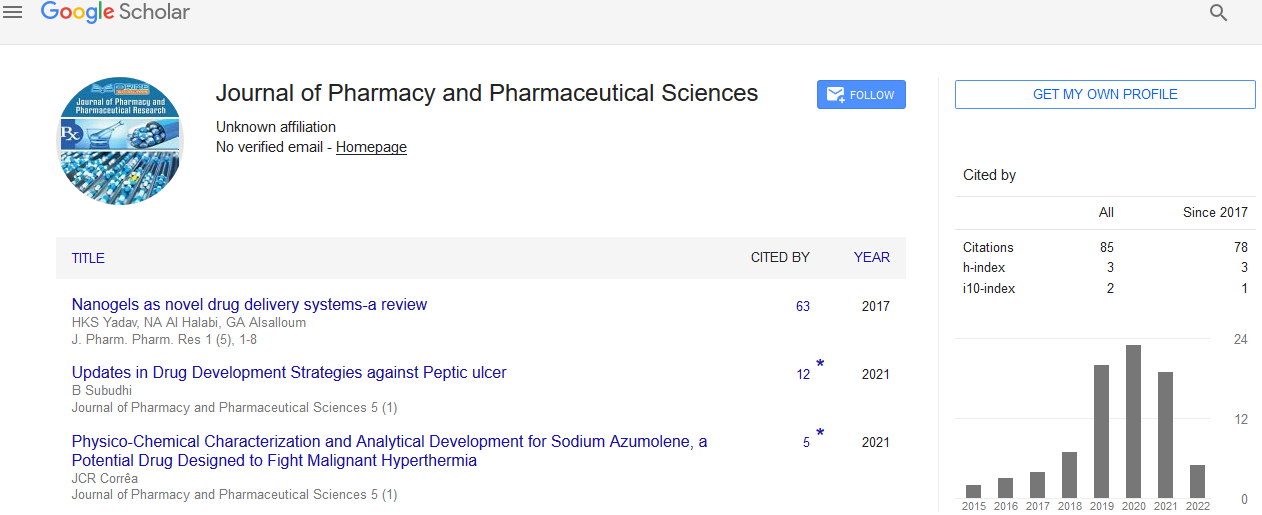Short Communication - (2024) Volume 8, Issue 1
Enhancing Pediatric Care: The Importance of Oral Suspensions in Pediatric Drug Delivery
Samz Morg*
Department of Pharmacy, Aristotle University of Thessaloniki, Greece
*Correspondence:
Samz Morg,
Department of Pharmacy, Aristotle University of Thessaloniki,
Greece,
Email:
Received: 28-Feb-2024, Manuscript No. IPIPR-24-19911;
Editor assigned: 01-Mar-2024, Pre QC No. IPIPR-24-19911 (PQ);
Reviewed: 15-Mar-2024, QC No. IPIPR-24-19911;
Revised: 20-Mar-2024, Manuscript No. IPIPR-24-19911 (R);
Published:
27-Mar-2024, DOI: 10.21767/ipipr.8.01.009
Introduction
When it comes to administering medications to pediatric
patients, ensuring safety, efficacy, and palatability is paramount.
However, pediatric populations pose unique challenges in
drug delivery due to factors such as age-related differences in
swallowing ability, taste preferences, and dosage requirements.
In this context, oral suspensions emerge as a preferred dosage
form for pediatric patients, offering flexibility, accuracy, and
ease of administration. This article explores the significance of
pediatric oral suspensions in pediatric healthcare and highlights
their role in improving medication adherence and therapeutic
outcomes in children. Pediatric oral suspensions are liquid
dosage forms consisting of finely divided drug particles
suspended in a liquid vehicle, typically water with additives
such as suspending agents, flavoring agents, and sweeteners.
Unlike solutions, which are homogeneous mixtures of drug
molecules dissolved in a liquid, suspensions contain insoluble
drug particles that settle over time and require shaking before
administration to ensure uniform drug distribution.
Description
The formulation of pediatric oral suspensions involves careful
consideration of factors such as drug solubility, stability,
palatability, and dosing accuracy. Suspensions allow for
precise titration of doses to accommodate the varying weight
and age-based dosage requirements of pediatric patients,
ensuring optimal therapeutic outcomes while minimizing the
risk of under- or overdosing. Pediatric oral suspensions offer
several advantages over other dosage forms, making them
well-suited for pediatric drug delivery: The liquid formulation
of oral suspensions facilitates easy swallowing and masks
the unpleasant taste of medications, enhancing patient
acceptance and compliance, particularly in young children
who may have aversions to solid dosage forms or bitter-tasting
medications. Oral suspensions allow for flexible dosing based
on the individualized needs of pediatric patients, enabling
healthcare providers to titrate doses accurately according to
body weight, age, and therapeutic response. The liquid nature
of oral suspensions facilitates precise measurement and
administration of doses using calibrated oral syringes or dosing
cups, reducing the risk of dosing errors and ensuring consistent
drug delivery. Pediatric oral suspensions can accommodate a
wide range of drug molecules, including poorly water-soluble
drugs, allowing for the formulation of diverse therapeutic
agents in a convenient and palatable dosage form. The finely
divided drug particles in oral suspensions provide a large
surface area for drug dissolution and absorption, promoting
rapid onset of action and improved bioavailability compared
to solid dosage forms. Oral suspensions are commonly
used to administer antibiotics to pediatric patients for the
treatment of bacterial infections, offering convenient dosing
and improved palatability compared to tablets or capsules.
Pediatric oral suspensions are utilized for the administration of
gastrointestinal medications, including proton pump inhibitors,
antacids, and antiemetics, for the management of conditions
such as gastroesophageal reflux disease, gastritis, and nausea/
vomiting [1-4].
Conclusion
Suspension formulations of analgesic and antipyretic
medications, such as acetaminophen and ibuprofen, provide
effective relief of pain and fever in children, with the added
benefit of easy administration and rapid onset of action. Pediatric
oral suspensions play a vital role in pediatric healthcare, offering
a safe, effective, and palatable dosage form for administering
medications to children. By addressing the unique needs and
preferences of pediatric patients, oral suspensions enhance medication adherence, improve therapeutic outcomes, and
promote better patient experiences. As healthcare providers
continue to prioritize patient-centered care, the formulation
and utilization of pediatric oral suspensions will remain integral
to optimizing pediatric drug delivery and advancing pediatric
pharmacotherapy.
Acknowledgement
The author is grateful to the journal editor and the anonymous
reviewers for their helpful comments and suggestions.
Conflict Of Interest
The author declared no potential conflicts of interest for the
research, authorship, and or publication of this article.
References
- Strickley RG (2019) Pediatric oral formulations: An updated review of commercially available pediatric oral formulations since 2007. J Pharm Sci 108(4):1335-1365.
[Crossref] [Google Scholar] [PubMed]
- Kean EA, Adeleke OA (2023) Orally disintegrating drug carriers for paediatric pharmacotherapy. Eur J Pharm Sci 182(3):106377.
[Crossref] [Google Scholar] [PubMed]
- Ejeta F (2022) Recent formulation advances and preparation of orally disintegrating tablets. Int J Pharm Compd 26(5):370-377.
[Crossref] [Google Scholar] [PubMed]
- Tangden T (2014) Combination antibiotic therapy for multidrug-resistant gram-negative bacteria. Ups J Med Sci 119(2):149-53.
[Crossref] [Google Scholar] [PubMed]
Citation: Morg S (2024) Enhancing Pediatric Care: The Importance of Oral Suspensions in Pediatric Drug Delivery. J Pharm Pharm
Res. 8:009
Copyright: 2024 Morg S. This is an open-access article distributed under the terms of the Creative Commons Attribution License, which permits unrestricted use, distribution, and reproduction in any medium, provided the original author and source are credited.

